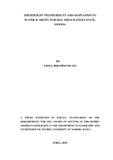| dc.description.abstract | Water supply is one of the world’s most pressing issues of the 21st century and its
scarcity and consequent stress is now the single greatest threat to human health, the
environment, global food supply as well as economic and social development (IDRC,
2002). In Sub-Saharan Africa, domestic water use accounts for only 9% of
consumptive water demands (WRI, 1994), but limited water availability to satisfy this
need is a major concern in rural areas of the semi-arid zones especially in northern
Nigeria. The study addressed the role of limited and insufficient knowledge on socioeconomic,
political and biophysical factors in vulnerability to water scarcity in
Katsina State. Solutions to stated problems were expected to assist in determining the
extent of vulnerability to water scarcity, differences in vulnerability to water scarcity,
factors affecting adaptation to vulnerability and finally constraints in adaptation and
adoption. The general hypothesis that was used to guide in achieving the study
objectives was that the status of vulnerability to water scarcity does not vary from one
rainfall zone to another within the Katsina State.
To realise the objectives of the study, a comprehensive review of literature on current
research trends and methods in the field of vulnerability and adaptation to household
water scarcity was conducted topically guided by the literature review, a conceptual
framework was developed on which the study method was anchored. The data used in
the study were mostly primary data on household characteristics, household water
demand and water availability which were collected through field survey. In some
cases, secondary data sourced from existing databases were used especially in dealing
with households’ numbers, rainfall distribution and spatial information. Field data
collection procedure involved multi-stage sampling procedure guided by the three
differentiated rainfall Zones of Katsina State while secondary data was collected
purposefully. A total of 400 households were sampled from each of the three rainfall
zones of the state totaling 1200 households plus 12 focus group discussions and 12
key informants. The resulting sample data were used in the computation of the Water
Scarcity Vulnerability Index (WSVI) as a ratio of Household water availability
(HHWA) to Household water demand (HHWD) for each rainfall zone to get the
spatial extent of household vulnerability to water scarcity. This resulted into five
categories of vulnerability to water scarcity and these were acute, high, moderate, low
and no scarcity. The results of vulnerability computation together with adaptation
strategies were subjected to descriptive and inferential statistical analyses as well as
spatial analyses to provide measures of distribution tendencies, dispersions,
differences and associations. The statistical techniques used included frequency
analyses (tabulation and graphing), crosstabulation analyses, one-way ANOVA, chisquares
test and Kruskal-Wallis H-test. All the statistical tests were at α 0.05 (i.e. 95%
level of confidence).
The results of data analysis established that across the three rainfall zones of the rural
areas of Katsina State water availability per capita was 26 litres per day as compared
to the UNDP, (2006) recommendation for Nigeria of 38 litres per day indicating
general water scarcity condition. Further, the WHO (2003) estimation of water access
was found to under estimate the water access problem in rural Katsina State because it
did not take into account other households water demands other than the human
needs. There was significant difference in per capita water availability and this
difference was due to rainfall variability thus reflecting the general geography of
water availability in Africa with a tendency to have water scarcity increase with the
distance away from the equator especially to the north. The indicators of vulnerability
to water scarcity in the study area included low levels in formal education,
inappropriate training in managing water scarcity, high poverty levels, over reliance
on nature for water supply, sharing of water sources with livestock and wild life, long
distances to water sources and minimal government involvement in water supply.
Adapting to water scarcity in rural Katsina State tended to vary with rainfall and
households characteristics and the strategies involved were generally with any
difference being a chance event. Formal knowledge was found to play insignificant
role in water scarcity adaptation strategies as compared to the role of traditional
knowledge in the study area. The government role in water scarcity adaptation
strategy was peripheral. There was general lack of government policy on adaptation to
water scarcity in Katsina State. Water pricing which need to be guided by government
policy was generally opposed by communities in rural Katsina State and this
conformed to global picture on opposition to water pricing on the basis of human
right. The socio-economic factors affecting adaptation to water scarcity were
identified as high cost of modern technology, weak local technology, weak
community organizations, weak formal institutions, low income levels, lack of social
cohesion and poor health conditions.
Generally rural Katsina State, on the basis of water scarcity vulnerability index, was
found to be water scarce and vulnerability largely depended on rainfall conditions but
moderated by socio-economic characteristics of households. The study established
that there was general low adoption and assimilation of development plans relating to
water scarcity. It was recommended that there should be diversification of livelihoods,
improvement of income levels through suitable income generating activities and,
increased government involvement in activities that would be alleviating vulnerability
to water scarcity. | en_US |

